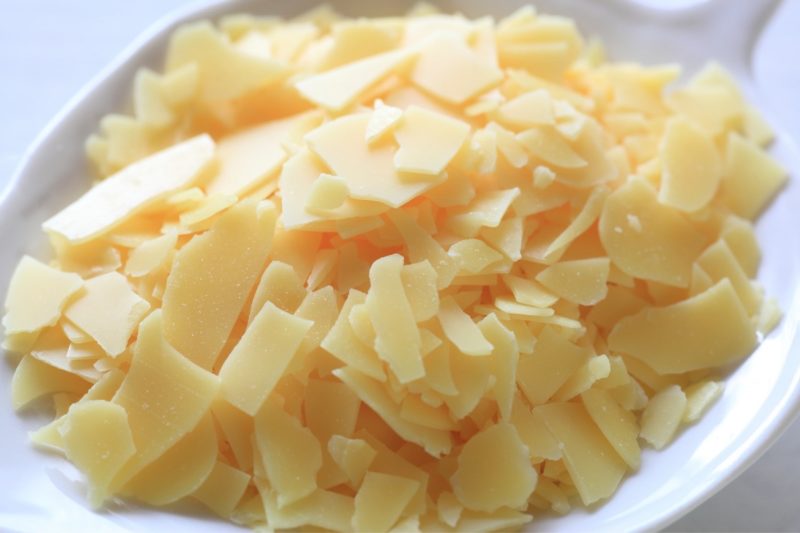
Vegan Waxes
What are vegan waxes? Waxes belong to the group lipids and generally have higher melting points above 60°C/140°F. Waxes are a combination of hydrocarbons and fatty esters. Plant-based or vegan waxes come from different plants, trees, fruits, flowers, or even seeds. There are many benefits for cosmetic formulators and makers to select vegan waxes over alternatives. Benefits include promoting sustainability, cruelty-free, and creating 100% Vegan Cosmetics. Many people don’t realize beeswax is considered an animal derived wax. Beeswax can not be in vegan and plant-based formulations. There are now many vegan waxes available that are also versatile and can easily replace animal derived waxes. Read below to learn about different kinds of plant-based and vegan waxes.
List of Vegan Plant Waxes
Candelilla Wax
INCI name: Euphorbia Cerifera (Candelilla) Wax
About: Candelilla is a hard vegetable wax. It is derived from the tree or shrub, Euphorbia Antisyphilitica and Pedilanthus Pavonis from the desert in Mexico. This wax has been used in chewing gum, car waxes and cosmetics. Candelilla wax adds sheen to formulations and produces excellent gloss and structure.
Uses: Lotion bars, lipsticks, lip gloss, sunscreen, emulsions and lubricants
Melting Point: 68.5-72.5°C/155.3-162.5°F
Color: Yellow
Special Instructions: Add to the oil phase and completely melt until the mixture is translucent.
EcoCert and COSMOS: Approved
Carnauba Wax
INCI name: Copernicia Cerifera (Carnauba) Wax
About: Carnauba is a plant wax and comes from the Brazilian tropical palm, the “Tree of Life”, from a coating on the leaves. It’s the hardest natural waxes. It is a structural agent and high in esters. Carnauba wax is used in food, candy, to coat medicine tablets and polish for cars. Carnauba wax is mostly used as a barrier and structural agent in cosmetics like lipsticks, lip and body balms. It combines well with candelilla wax.
Uses: Adds body, a light sheen to formulations. Used in lipstick, body balms.
Melting Point: 80-86°C/176-187°F, highest melting point of natural waxes.
Color: Generally yellow or brownish-green.
EcoCert and COSMOS: Approved
Special Instructions: To use carnauba wax in your recipe, it must be heated to a higher melting point than beeswax. Carnauba wax is harder than beeswax.
Rice Bran Wax
INCI Name: Oryza Sativa (Rice) Bran Wax
About: Rice bran wax comes from the leafy portion of the rice plant. It is high in esters and similar to carnauba, making it an excellent alternative to carnauba wax. Found in a variety of cosmetic formulations. Can be used as a thickener and works well as a binding, coating and gelling agent.
Uses: Lipsticks, lip balms, sun care products, bar products
Melting Point: 77-86°C/171-187°F
Color: Light yellow
EcoCert and COSMOS: Approved
Additional: Rice bran wax has an outstanding oil binding property compared to other waxes.
Myrica Fruit Wax – Laurel Wax
INCI Name: Myrica Pubescens (Laurel) Fruit Wax
About: Derived from berry fruit peels from the Myrica Pubescens tree native to Latin America. Also known as Laurel Wax. It’s a very unique wax since it lacks double bonds and it is a natural “hydrogenated” oil when solid. It is very stable against oxidation with a very low melting point and has outstanding spreadability.
Uses: Hair Styling Products, hair conditioner, hair pomade, lip products, creams and lotions
Melting Point: 45-55°C/113-131°F
Color: Greenish to white
Special Instructions: Add to oil phase. Note low melting point.
EcoCert and COSMOS: Approved
Berry Wax
INCI Name: Rhus Verniciflua (Berry) Peel Wax
About: Berry wax is derived from berry fruit peels of the Rhus Verniciflua tree native in China. Berry wax is also referred to as Japan wax. It’s called a vegan beeswax, a replacement for beeswax. It acts as an emollient with a soft and silky feel in formulations.
Uses: Balms, oleogels, lipsticks, lip gloss, pomades
Melting Point: 48- 54°C/118-129°F
Color: Pale yellow
Special Instructions: Berry wax has a low melting point and is a soft wax. For solid formulations such as deodorant sticks, bars or lipsticks, a hard wax must also be used.
EcoCert and COSMOS: Approved
Sunflower Wax
INCI Name: Helianthus Annuus (Sunflower) Seed Wax
About: Sunflower wax is produced through the winterization of sunflower oil. It’s used in a wide variety of cosmetics. Sunflower wax is an excellent emulsifier with a high melting point. It is an excellent choice for higher temperatures or products used in the summer weather. Sunflower wax can improve the consistency of a product by binding oil and water together and therefore creating a smooth texture.
Uses: Balms, lipsticks, salves, lotions, deodorants
Melting Point: 74-77°C/165-176°F
Color: Light yellow
EcoCert and COSMOS: Approved!
How to Select a Vegan Plant Wax for your Formulation
1. Choose a higher melting point if:
Outside temperatures are high, delivery temperatures are high, product has unwanted spreading, final product needs to be hard texture (i.e. deodorant stick, lip stick).
A higher melting point means, the harder the wax of the finished product.
2. Choose a lower melting point if:
Making a soft or spreadable skin care balm or lip balm.
Note, all waxes provide different properties to your final product. You should first consider what hardness you want in your final product to be and note any climate issues. Sometimes finding the correct balance of hardness and spreadability can take time to test. This can also change as the seasons change, with containers, or change of ingredients. Being a cosmetic formulator, maker, and compounder, can include finding that perfect blending of waxes to find that perfect balance.
You might also like


Do you know where I can purchase Berry wax in North America?